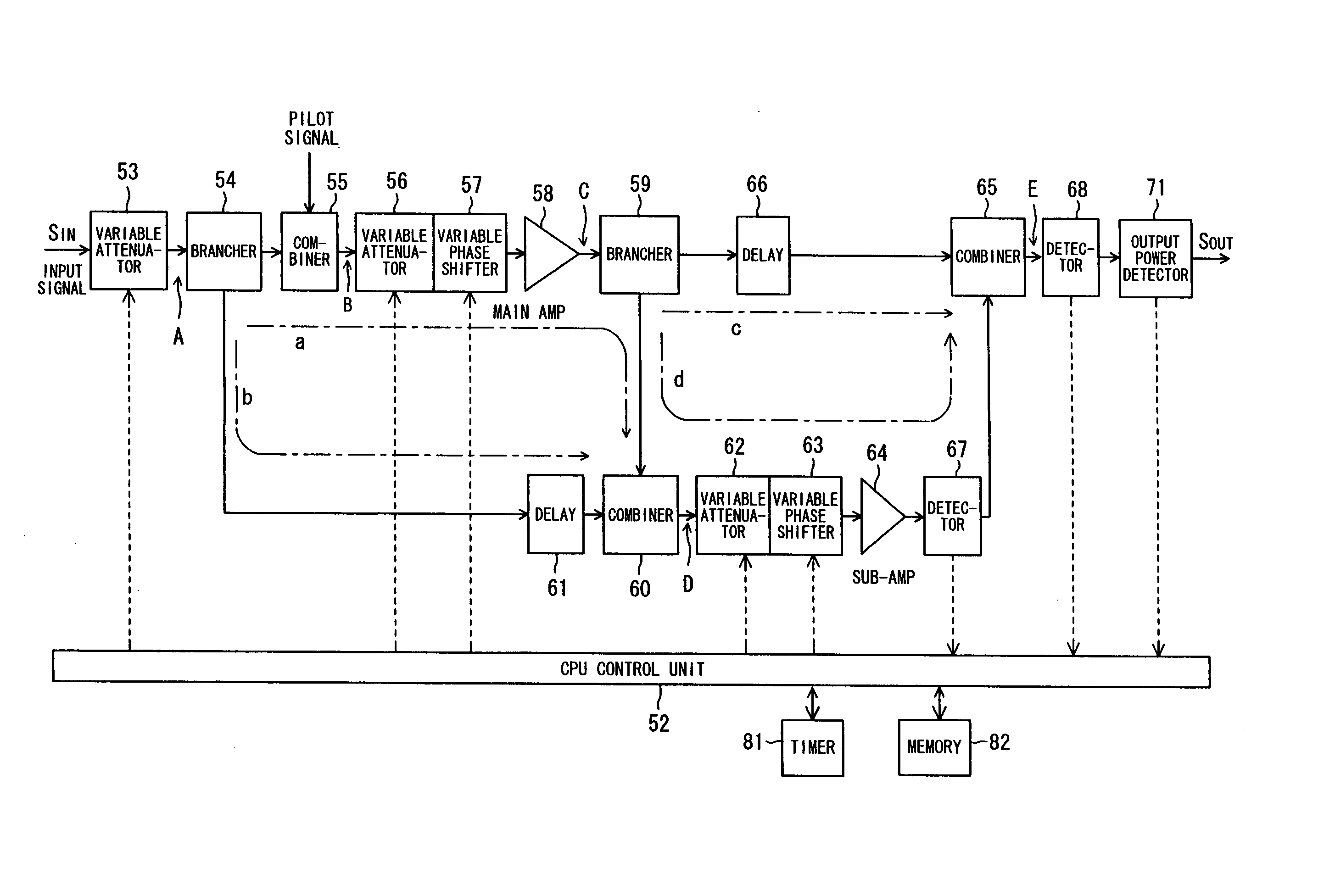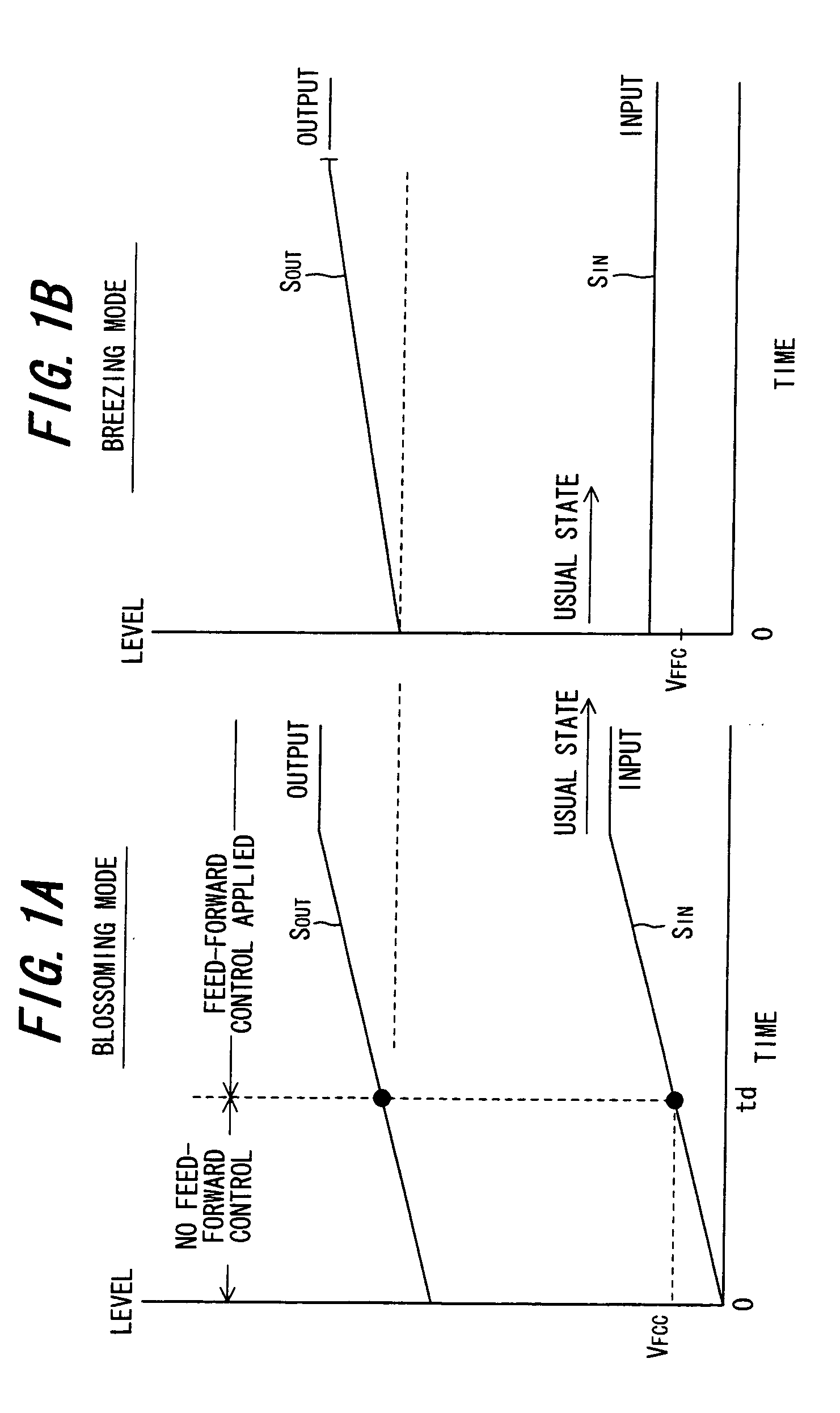Transmission power amplifier unit
a technology of transmission power amplifier and amplifier, which is applied in the direction of amplifier modification, power management, wireless communication, etc., can solve the problems of a comparatively long time required to settle in the steady state, the call processing cannot keep pace, and the inability to receive, so as to improve the output power (transmission power) of the transmission power amplifier unit, the non-linear distortion of the main amp can be compensated quickly, and the gain increase.
- Summary
- Abstract
- Description
- Claims
- Application Information
AI Technical Summary
Benefits of technology
Problems solved by technology
Method used
Image
Examples
first embodiment
(B) First Embodiment
[0050]FIG. 2 is a diagram showing the structure of a high-power amplifier (HPA) according to a first embodiment of the present invention.
[0051] An input power detector 51, which is provided on the input side of the high-power amplifier, detects the input power SIN and inputs the result to a control unit 52. FIG. 3 is a diagram showing the structure of the level detector 51. The input power SIN is branched by a coupler 51a such as a unidirectional coupler, and one branched signal is input to a variable attenuator 53. The other branched signal is input to an RSSI (Receive Signal Strength Indicator) circuit 51c via an isolator 51b. The RSSI circuit 51c converts the power of the input signal to voltage and inputs the voltage to an amplifier 51d, where the signal is subjected to the necessary amplification and then input to an AD converter 51e. The AD converter 51e converts the input voltage to a digital signal and inputs the digital signal to the control unit 52.
[0...
second embodiment
(C) Second Embodiment
[0070]FIG. 6 is a diagram showing the structure of a high-power amplifier (HPA) according to a second embodiment of the present invention. Components identical with those of the first embodiment of FIG. 2 are designated by like reference characters. This embodiment differs-from the first embodiment in that: [0071] (1) an output power detector 71 is provided instead of the input power detector 51; [0072] (2) the control unit 52 converts the detected value from the output power detector 71 to input power based upon the gain of the high-power amplifier; and [0073] (3) mode discrimination and attenuation control (gain control) are carried out in accordance with the flowchart of FIG. 4 based upon the input power obtained by the conversion.
[0074] As shown in FIG. 7, the output power detector 71 has a structure identical with that of the input power detector 51 of the first embodiment. The output power SOUT is branched by a coupler 71a such as a unidirectional coupler...
third embodiment
(D) Third Embodiment
[0075] When the blossoming mode is in effect, there are instances where the input power SIN to the high-power amplifier fluctuates for some reason, as shown in FIG. 8. In such case the output power SOUT of the high-power amplifier also will fluctuate in the manner indicated, the transmission power of the base station will no longer vary linearly with respect to time and it will no longer be possible to exercise the original power control that attempts to enlarge the cell (the transmission area) gradually in proportion to time. Accordingly, it is necessary to control the transmission power of the base station in the manner indicated by the dashed line SIDL.
[0076]FIG. 9 is a diagram showing the structure of a high-power amplifier according to a third embodiment for controlling transmission power linearly with respect to a non-linear input. Components identical with those of the second embodiment of FIG. 6 are designated by like reference characters. This embodimen...
PUM
 Login to View More
Login to View More Abstract
Description
Claims
Application Information
 Login to View More
Login to View More - R&D
- Intellectual Property
- Life Sciences
- Materials
- Tech Scout
- Unparalleled Data Quality
- Higher Quality Content
- 60% Fewer Hallucinations
Browse by: Latest US Patents, China's latest patents, Technical Efficacy Thesaurus, Application Domain, Technology Topic, Popular Technical Reports.
© 2025 PatSnap. All rights reserved.Legal|Privacy policy|Modern Slavery Act Transparency Statement|Sitemap|About US| Contact US: help@patsnap.com



